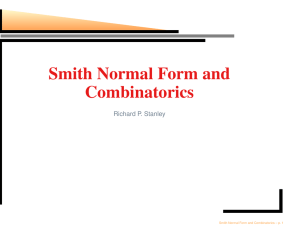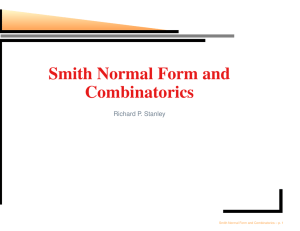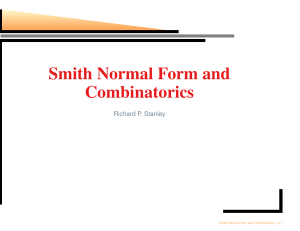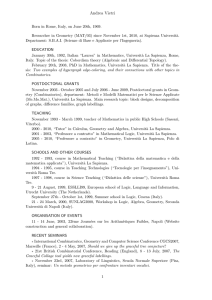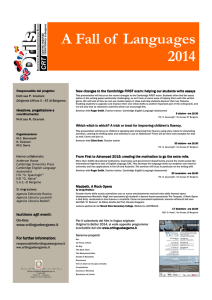Smith Normal Form and Combinatorics Richard P. Stanley
advertisement
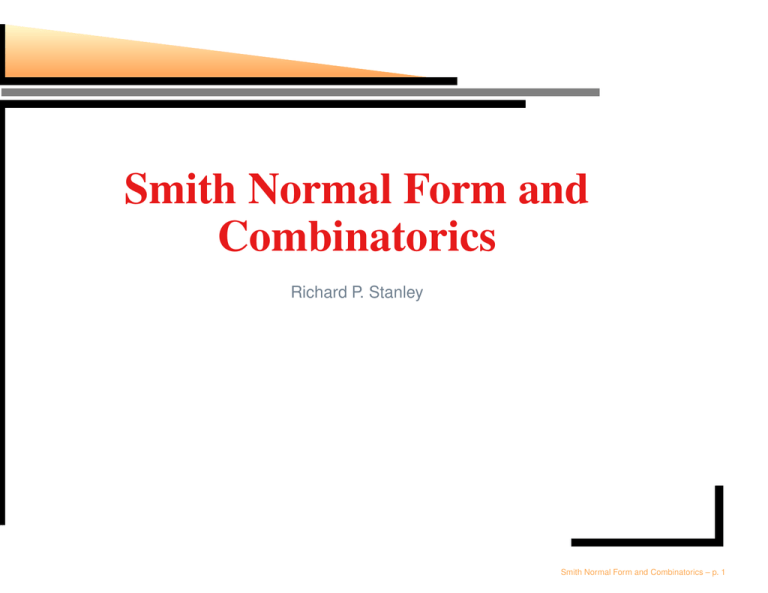
Smith Normal Form and
Combinatorics
Richard P. Stanley
Smith Normal Form and Combinatorics – p. 1
Smith normal form
A: n × n matrix over commutative ring R (with 1)
Suppose there exist P , Q ∈ GL(n, R) such that
P AQ := B = diag(d1 , d1 d2 , . . . d1 d2 · · · dn ),
where di ∈ R. We then call B a Smith normal
form (SNF) of A.
Smith Normal Form and Combinatorics – p. 2
Smith normal form
A: n × n matrix over commutative ring R (with 1)
Suppose there exist P , Q ∈ GL(n, R) such that
P AQ := B = diag(d1 , d1 d2 , . . . d1 d2 · · · dn ),
where di ∈ R. We then call B a Smith normal
form (SNF) of A.
N OTE . (1) Can extend to m × n.
(2) unit · det(A) = det(B) = dn1 dn−1
· · · dn .
2
Thus SNF is a refinement of det.
Smith Normal Form and Combinatorics – p. 2
Row and column operations
Can put a matrix into SNF by the following
operations.
Add a multiple of a row to another row.
Add a multiple of a column to another column.
Multiply a row or column by a unit in R.
Smith Normal Form and Combinatorics – p. 3
Row and column operations
Can put a matrix into SNF by the following
operations.
Add a multiple of a row to another row.
Add a multiple of a column to another column.
Multiply a row or column by a unit in R.
Over a field, SNF is row reduced echelon form
(with all unit entries equal to 1).
Smith Normal Form and Combinatorics – p. 3
Existence of SNF
If R is a PID, such as Z or K[x] (K = field), then
A has a unique SNF up to units.
Smith Normal Form and Combinatorics – p. 4
Existence of SNF
If R is a PID, such as Z or K[x] (K = field), then
A has a unique SNF up to units.
Otherwise A “typically” does not have a SNF but
may have one in special cases.
Smith Normal Form and Combinatorics – p. 4
Algebraic interpretation of SNF
R: a PID
A: an n × n matrix over R with rows
v1 , . . . , vn ∈ Rn
diag(e1 , e2 , . . . , en ): SNF of A
Smith Normal Form and Combinatorics – p. 5
Algebraic interpretation of SNF
R: a PID
A: an n × n matrix over R with rows
v1 , . . . , vn ∈ Rn
diag(e1 , e2 , . . . , en ): SNF of A
Theorem.
Rn /(v1 , . . . , vn ) ∼
= (R/e1 R) ⊕ · · · ⊕ (R/en R).
Smith Normal Form and Combinatorics – p. 5
Algebraic interpretation of SNF
R: a PID
A: an n × n matrix over R with rows
v1 , . . . , vn ∈ Rn
diag(e1 , e2 , . . . , en ): SNF of A
Theorem.
Rn /(v1 , . . . , vn ) ∼
= (R/e1 R) ⊕ · · · ⊕ (R/en R).
Rn /(v1 , . . . , vn ): (Kastelyn) cokernel of A
Smith Normal Form and Combinatorics – p. 5
An explicit formula for SNF
R: a PID
A: an n × n matrix over R with det(A) 6= 0
diag(e1 , e2 , . . . , en ): SNF of A
Smith Normal Form and Combinatorics – p. 6
An explicit formula for SNF
R: a PID
A: an n × n matrix over R with det(A) 6= 0
diag(e1 , e2 , . . . , en ): SNF of A
Theorem. e1 e2 · · · ei is the gcd of all i × i minors
of A.
minor: determinant of a square submatrix.
Special case: e1 is the gcd of all entries of A.
Smith Normal Form and Combinatorics – p. 6
An example
Reduced Laplacian matrix of K4 :
3 −1 −1
A = −1 3 −1
−1 −1 3
Smith Normal Form and Combinatorics – p. 7
An example
Reduced Laplacian matrix of K4 :
3 −1 −1
A = −1 3 −1
−1 −1 3
Matrix-tree theorem =⇒ det(A) = 16, the
number of spanning trees of K4 .
Smith Normal Form and Combinatorics – p. 7
An example
Reduced Laplacian matrix of K4 :
3 −1 −1
A = −1 3 −1
−1 −1 3
Matrix-tree theorem =⇒ det(A) = 16, the
number of spanning trees of K4 .
What about SNF?
Smith Normal Form and Combinatorics – p. 7
An example (continued)
3 −1 −1 0 0 −1 0
−1 3 −1 → −4 4 −1 → −4
−1 −1 3
8 −4 3
8
0 0 −1
0 0 −1
→0 4 0→0 4 0→
4 −4 0
4 0 0
0 −1
4 0
−4 0
4 0 0
0 4 0
0 0 1
Smith Normal Form and Combinatorics – p. 8
Laplacian matrices
L0 (G): reduced Laplacian matrix of the graph G
Matrix-tree theorem. det L0 (G) = κ(G), the
number of spanning trees of G.
Smith Normal Form and Combinatorics – p. 9
Laplacian matrices
L0 (G): reduced Laplacian matrix of the graph G
Matrix-tree theorem. det L0 (G) = κ(G), the
number of spanning trees of G.
SNF
Theorem. L0 (Kn ) −→ diag(1, n, n, . . . , n), a
refinement of Cayley’s theorem that
κ(Kn ) = nn−2 .
Smith Normal Form and Combinatorics – p. 9
Laplacian matrices
L0 (G): reduced Laplacian matrix of the graph G
Matrix-tree theorem. det L0 (G) = κ(G), the
number of spanning trees of G.
SNF
Theorem. L0 (Kn ) −→ diag(1, n, n, . . . , n), a
refinement of Cayley’s theorem that
κ(Kn ) = nn−2 .
In general, SNF of L0 (G) not understood.
Smith Normal Form and Combinatorics – p. 9
Chip firing
Abelian sandpile: a finite collection σ of
indistinguishable chips distributed among the
vertices V of a (finite) connected graph.
Equivalently,
σ : V → {0, 1, 2, . . . }.
Smith Normal Form and Combinatorics – p. 10
Chip firing
Abelian sandpile: a finite collection σ of
indistinguishable chips distributed among the
vertices V of a (finite) connected graph.
Equivalently,
σ : V → {0, 1, 2, . . . }.
toppling of a vertex v: if σ(v) ≥ deg(v), then
send a chip to each neighboring vertex.
0
5
6
1
2
7
1
2
2
1
3
2
Smith Normal Form and Combinatorics – p. 10
The sandpile group
Choose a vertex to be a sink, and ignore chips
falling into the sink.
stable configuration: no vertex can topple
Theorem (easy). After finitely many topples a
stable configuration will be reached, which is
independent of the order of topples.
Smith Normal Form and Combinatorics – p. 11
The monoid of stable configurations
Define a commutative monoid M on the stable
configurations by vertex-wise addition followed
by stabilization.
ideal of M : subset J ⊆ M satisfying σJ ⊆ J for
all σ ∈ M
Smith Normal Form and Combinatorics – p. 12
The monoid of stable configurations
Define a commutative monoid M on the stable
configurations by vertex-wise addition followed
by stabilization.
ideal of M : subset J ⊆ M satisfying σJ ⊆ J for
all σ ∈ M
Exercise. The (unique) minimal ideal of a finite
commutative monoid is a group.
Smith Normal Form and Combinatorics – p. 12
Sandpile group
sandpile group of G: the minimal ideal K(G) of
the monoid M
Fact. K(G) is independent of the choice of sink
up to isomorphism.
Smith Normal Form and Combinatorics – p. 13
Sandpile group
sandpile group of G: the minimal ideal K(G) of
the monoid M
Fact. K(G) is independent of the choice of sink
up to isomorphism.
Theorem. Let
SNF
L0 (G) −→ diag(e1 , . . . , en−1 ).
Then
K(G) ∼
= Z/e1 Z ⊕ · · · ⊕ Z/en−1 Z.
Smith Normal Form and Combinatorics – p. 13
Second example
Some matrices connected with Young
diagrams
Smith Normal Form and Combinatorics – p. 14
Extended Young diagrams
λ: a partition (λ1 , λ2 , . . . ), identified with its Young
diagram
(3,1)
Smith Normal Form and Combinatorics – p. 15
Extended Young diagrams
λ: a partition (λ1 , λ2 , . . . ), identified with its Young
diagram
(3,1)
λ∗ : λ extended by a border strip along its entire
boundary
Smith Normal Form and Combinatorics – p. 15
Extended Young diagrams
λ: a partition (λ1 , λ2 , . . . ), identified with its Young
diagram
(3,1)
λ∗ : λ extended by a border strip along its entire
boundary
(3,1)* = (4,4,2)
Smith Normal Form and Combinatorics – p. 15
Initialization
Insert 1 into each square of λ∗ /λ.
1
1
1
1
1 1
(3,1)* = (4,4,2)
Smith Normal Form and Combinatorics – p. 16
Mt
Let t ∈ λ. Let Mt be the largest square of λ∗ with
t as the upper left-hand corner.
Smith Normal Form and Combinatorics – p. 17
Mt
Let t ∈ λ. Let Mt be the largest square of λ∗ with
t as the upper left-hand corner.
t
Smith Normal Form and Combinatorics – p. 17
Mt
Let t ∈ λ. Let Mt be the largest square of λ∗ with
t as the upper left-hand corner.
t
Smith Normal Form and Combinatorics – p. 17
Determinantal algorithm
Suppose all squares to the southeast of t have
been filled. Insert into t the number nt so that
det Mt = 1.
Smith Normal Form and Combinatorics – p. 18
Determinantal algorithm
Suppose all squares to the southeast of t have
been filled. Insert into t the number nt so that
det Mt = 1.
1
1
1 1
1 1
Smith Normal Form and Combinatorics – p. 18
Determinantal algorithm
Suppose all squares to the southeast of t have
been filled. Insert into t the number nt so that
det Mt = 1.
1
2 1
1 1
1 1
Smith Normal Form and Combinatorics – p. 18
Determinantal algorithm
Suppose all squares to the southeast of t have
been filled. Insert into t the number nt so that
det Mt = 1.
2 1
2 1 1
1 1 1
Smith Normal Form and Combinatorics – p. 18
Determinantal algorithm
Suppose all squares to the southeast of t have
been filled. Insert into t the number nt so that
det Mt = 1.
2 1
3 2 1 1
1 1 1
Smith Normal Form and Combinatorics – p. 18
Determinantal algorithm
Suppose all squares to the southeast of t have
been filled. Insert into t the number nt so that
det Mt = 1.
5 2 1
3 2 1 1
1 1 1
Smith Normal Form and Combinatorics – p. 18
Determinantal algorithm
Suppose all squares to the southeast of t have
been filled. Insert into t the number nt so that
det Mt = 1.
9 5 2 1
3 2 1 1
1 1 1
Smith Normal Form and Combinatorics – p. 18
Uniqueness
Easy to see: the numbers nt are well-defined and
unique.
Smith Normal Form and Combinatorics – p. 19
Uniqueness
Easy to see: the numbers nt are well-defined and
unique.
Why? Expand det Mt by the first row. The
coefficient of nt is 1 by induction.
Smith Normal Form and Combinatorics – p. 19
λ(t)
If t ∈ λ, let λ(t) consist of all squares of λ to the
southeast of t.
Smith Normal Form and Combinatorics – p. 20
λ(t)
If t ∈ λ, let λ(t) consist of all squares of λ to the
southeast of t.
t
λ = (4,4,3)
Smith Normal Form and Combinatorics – p. 20
λ(t)
If t ∈ λ, let λ(t) consist of all squares of λ to the
southeast of t.
t
λ = (4,4,3)
λ( t ) = (3,2)
Smith Normal Form and Combinatorics – p. 20
uλ
uλ = #{µ : µ ⊆ λ}
Smith Normal Form and Combinatorics – p. 21
uλ
uλ = #{µ : µ ⊆ λ}
Example. u(2,1) = 5:
φ
Smith Normal Form and Combinatorics – p. 21
uλ
uλ = #{µ : µ ⊆ λ}
Example. u(2,1) = 5:
φ
There is a determinantal formula for uλ , due
essentially to MacMahon and later Kreweras
(not needed here).
Smith Normal Form and Combinatorics – p. 21
Carlitz-Scoville-Roselle theorem
Berlekamp (1963) first asked for nt (mod 2)
in connection with a coding theory problem.
Carlitz-Roselle-Scoville (1971):
combinatorial interpretation of nt (over Z).
Smith Normal Form and Combinatorics – p. 22
Carlitz-Scoville-Roselle theorem
Berlekamp (1963) first asked for nt (mod 2)
in connection with a coding theory problem.
Carlitz-Roselle-Scoville (1971):
combinatorial interpretation of nt (over Z).
Theorem. nt = f (λ(t)).
Smith Normal Form and Combinatorics – p. 22
Carlitz-Scoville-Roselle theorem
Berlekamp (1963) first asked for nt (mod 2)
in connection with a coding theory problem.
Carlitz-Roselle-Scoville (1971):
combinatorial interpretation of nt (over Z).
Theorem. nt = f (λ(t)).
Proofs. 1. Induction (row and column
operations).
2. Nonintersecting lattice paths.
Smith Normal Form and Combinatorics – p. 22
An example
7 3
2
1
2 1 1
1 1
1
Smith Normal Form and Combinatorics – p. 23
An example
7 3
2
1
2 1 1
1 1
1
φ
Smith Normal Form and Combinatorics – p. 23
Many indeterminates
For each square (i, j) ∈ λ, associate an
indeterminate xij (matrix coordinates).
Smith Normal Form and Combinatorics – p. 24
Many indeterminates
For each square (i, j) ∈ λ, associate an
indeterminate xij (matrix coordinates).
x11
x12
x13
x 21 x 22
Smith Normal Form and Combinatorics – p. 24
A refinement of uλ
uλ (x) =
X Y
xij
µ⊆λ (i,j)∈λ/µ
Smith Normal Form and Combinatorics – p. 25
A refinement of uλ
uλ (x) =
X Y
xij
µ⊆λ (i,j)∈λ/µ
a b c
d e
c
d e
µ
λ
Y
λ/µ
xij = cde
(i,j)∈λ/µ
Smith Normal Form and Combinatorics – p. 25
An example
a
b
d
e
c
abcde+bcde+bce+cde
+ce+de+c+e+1
bce+ce+c
+e+1
c+1
1
de+e+1
e+1
1
1
1
1
1
Smith Normal Form and Combinatorics – p. 26
At
At =
Y
xij
(i,j)∈λ(t)
Smith Normal Form and Combinatorics – p. 27
At
At =
Y
xij
(i,j)∈λ(t)
t
a
b c
d e
f
g h
i
j
n
k l
o
m
Smith Normal Form and Combinatorics – p. 27
At
At =
Y
xij
(i,j)∈λ(t)
t
a
b c
d e
f
g h
i
j
n
k l
o
m
At = bcdeghiklmo
Smith Normal Form and Combinatorics – p. 27
The main theorem
Theorem. Let t = (i, j). Then Mt has SNF
diag(Aij , Ai−1,j−1 , . . . , 1).
Smith Normal Form and Combinatorics – p. 28
The main theorem
Theorem. Let t = (i, j). Then Mt has SNF
diag(Aij , Ai−1,j−1 , . . . , 1).
Proof. 1. Explicit row and column operations
putting Mt into SNF.
2. (C. Bessenrodt) Induction.
Smith Normal Form and Combinatorics – p. 28
An example
a
b c
d
e
abcde+bcde+bce+cde
+ce+de+c+e+1
bce+ce+c
+e+1
c+1
1
de+e+1
e+1
1
1
1
1
1
Smith Normal Form and Combinatorics – p. 29
An example
a
b c
d
e
abcde+bcde+bce+cde
+ce+de+c+e+1
bce+ce+c
+e+1
c+1
1
de+e+1
e+1
1
1
1
1
1
SNF = diag(abcde, e, 1)
Smith Normal Form and Combinatorics – p. 29
A special case
Let λ be the staircase δn = (n − 1, n − 2, . . . , 1).
Set each xij = q.
Smith Normal Form and Combinatorics – p. 30
A special case
Let λ be the staircase δn = (n − 1, n − 2, . . . , 1).
Set each xij = q.
Smith Normal Form and Combinatorics – p. 30
A special case
Let λ be the staircase δn = (n − 1, n − 2, . . . , 1).
Set each xij = q.
uδn−1 (x)xij =q counts Dyck paths of length 2n by
(scaled) area, and is thus the well-known
q-analogue Cn (q) of the Catalan number Cn .
Smith Normal Form and Combinatorics – p. 30
A q -Catalan example
C3 (q) = q 3 + q 2 + 2q + 1
Smith Normal Form and Combinatorics – p. 31
A q -Catalan example
C3 (q) = q 3 + q 2 + 2q + 1
C (q) C (q) 1 + q
3
4
1
C3 (q) 1 + q
1+q
1
1
SNF
∼ diag(q 6 , q, 1)
Smith Normal Form and Combinatorics – p. 31
A q -Catalan example
C3 (q) = q 3 + q 2 + 2q + 1
C (q) C (q) 1 + q
3
4
1
C3 (q) 1 + q
1+q
1
1
SNF
∼ diag(q 6 , q, 1)
q-Catalan determinant previously known
SNF is new
Smith Normal Form and Combinatorics – p. 31
SNF of random matrices
Huge literature on random matrices, mostly
connected with eigenvalues.
Very little work on SNF of random matrices over
a PID.
Smith Normal Form and Combinatorics – p. 32
Is the question interesting?
Matk (n): all n × n Z-matrices with entries in
[−k, k] (uniform distribution)
pk (n, d): probability that if M ∈ Matk (n) and
SNF(M ) = (e1 , . . . , en ), then e1 = d.
Smith Normal Form and Combinatorics – p. 33
Is the question interesting?
Matk (n): all n × n Z-matrices with entries in
[−k, k] (uniform distribution)
pk (n, d): probability that if M ∈ Matk (n) and
SNF(M ) = (e1 , . . . , en ), then e1 = d.
Recall: e1 = gcd of 1 × 1 minors (entries) of M
Smith Normal Form and Combinatorics – p. 33
Is the question interesting?
Matk (n): all n × n Z-matrices with entries in
[−k, k] (uniform distribution)
pk (n, d): probability that if M ∈ Matk (n) and
SNF(M ) = (e1 , . . . , en ), then e1 = d.
Recall: e1 = gcd of 1 × 1 minors (entries) of M
n2
Theorem. limk→∞ pk (n, d) = 1/d ζ(n2 )
Smith Normal Form and Combinatorics – p. 33
Work of Yinghui Wang
Smith Normal Form and Combinatorics – p. 34
Work of Yinghui Wang (
)
Smith Normal Form and Combinatorics – p. 35
Work of Yinghui Wang (
)
Sample result. µk (n): probability that the SNF
of a random A ∈ Matk (n) satisfies e1 = 2, e2 = 6.
µ(n) = lim µk (n).
k→∞
Smith Normal Form and Combinatorics – p. 36
Conclusion
2
µ(n) = 2−n 1 −
n(n−1)
X
i=(n−1)2
2−i +
2
nX
−1
i=n(n−1)+1
2−i
3 −(n−1)2
−n 2
(n−1)2
· ·3
)(1 − 3 )
(1 − 3
2
2
n(n−1)
n
−1
Y
X
X
1 −
·
p−i .
p−i +
p>3
i=(n−1)2
i=n(n−1)+1
Smith Normal Form and Combinatorics – p. 37
A note on the proof
uses a 2014 result of C. Feng, R. W. Nóbrega, F.
R. Kschischang, and D. Silva, Communication
over finite-chain-ring matrix channels: number of
m × n matrices over Z/ps Z with specified SNF
Smith Normal Form and Combinatorics – p. 38
A note on the proof
uses a 2014 result of C. Feng, R. W. Nóbrega, F.
R. Kschischang, and D. Silva, Communication
over finite-chain-ring matrix channels: number of
m × n matrices over Z/ps Z with specified SNF
Note. Z/ps Z is not a PID, but SNF still exists
because its ideals form a finite chain.
Smith Normal Form and Combinatorics – p. 38
Cyclic cokernel
κ(n): probability that an n × n Z-matrix has SNF
diag(e1 , e2 , . . . , en ) with e1 = e2 = · · · = en−1 = 1.
Smith Normal Form and Combinatorics – p. 39
Cyclic cokernel
κ(n): probability that an n × n Z-matrix has SNF
diag(e1 , e2 , . . . , en ) with e1 = e2 = · · · = en−1 = 1.
Y
1
1
1
1 + 2 + 3 + ··· + n
p
p
p
p
Theorem. κ(n) =
ζ(2)ζ(3) · · ·
Smith Normal Form and Combinatorics – p. 39
Cyclic cokernel
κ(n): probability that an n × n Z-matrix has SNF
diag(e1 , e2 , . . . , en ) with e1 = e2 = · · · = en−1 = 1.
Y
1
1
1
1 + 2 + 3 + ··· + n
p
p
p
p
Theorem. κ(n) =
ζ(2)ζ(3) · · ·
Corollary. lim κ(n) =
n→∞
ζ(6)
1
Q
j≥4 ζ(j)
≈ 0.846936 · · · .
Smith Normal Form and Combinatorics – p. 39
Third example
In collaboration with Tommy Wuxing Cai.
Smith Normal Form and Combinatorics – p. 40
Third example
In collaboration with
.
Smith Normal Form and Combinatorics – p. 40
Third example
In collaboration with
.
Par(n): set of all partitions of n
E.g., Par(4) = {4, 31, 22, 211, 1111}.
Smith Normal Form and Combinatorics – p. 40
Third example
In collaboration with
.
Par(n): set of all partitions of n
E.g., Par(4) = {4, 31, 22, 211, 1111}.
Vn : real vector space with basis Par(n)
Smith Normal Form and Combinatorics – p. 40
U
Define U = Un : Vn → Vn+1 by
X
U (λ) =
µ,
µ
where µ ∈ Par(n + 1) and µi ≥ λi ∀i.
Example.
U (42211) = 52211 + 43211 + 42221 + 422111
Smith Normal Form and Combinatorics – p. 41
D
Dually, define D = Dn : Vn → Vn−1 by
X
D(λ) =
ν,
ν
where ν ∈ Par(n − 1) and νi ≤ λi ∀i.
Example. D(42211) = 32211 + 42111 + 4221
Smith Normal Form and Combinatorics – p. 42
Symmetric functions
N OTE . Identify Vn with the space ΛnQ of all
homogeneous symmetric functions of degree n
over Q, and identify λ ∈ Vn with the Schur
function sλ . Then
∂
f.
U (f ) = p1 f, D(f ) =
∂p1
Smith Normal Form and Combinatorics – p. 43
Commutation relation
Basic commutation relation: DU − U D = I
Allows computation of eigenvalues of
DU : Vn → Vn .
Or note that the eigenvectors of
pλ ’s, λ ⊢ n.
∂
∂p1 p1
are the
Smith Normal Form and Combinatorics – p. 44
Eigenvalues of DU
Let p(n) = #Par(n) = dim Vn .
Theorem. Let 1 ≤ i ≤ n + 1, i 6= n. Then i is an
eigenvalue of Dn+1 Un with multiplicity
p(n + 1 − i) − p(n − i). Hence
det Dn+1 Un =
n+1
Y
ip(n+1−i)−p(n−i) .
i=1
Smith Normal Form and Combinatorics – p. 45
Eigenvalues of DU
Let p(n) = #Par(n) = dim Vn .
Theorem. Let 1 ≤ i ≤ n + 1, i 6= n. Then i is an
eigenvalue of Dn+1 Un with multiplicity
p(n + 1 − i) − p(n − i). Hence
det Dn+1 Un =
n+1
Y
ip(n+1−i)−p(n−i) .
i=1
What about SNF of the matrix [Dn+1 Un ] (with
respect to the basis Par(n))?
Smith Normal Form and Combinatorics – p. 45
Conjecture of A. R. Miller, 2005
Conjecture (first form). Let e1 , . . . , ep(n) be the
eigenvalues of Dn+1 Un . Then [Dn+1 Un ] has the
same SNF as diag(e1 , . . . , ep(n) ).
Smith Normal Form and Combinatorics – p. 46
Conjecture of A. R. Miller, 2005
Conjecture (first form). Let e1 , . . . , ep(n) be the
eigenvalues of Dn+1 Un . Then [Dn+1 Un ] has the
same SNF as diag(e1 , . . . , ep(n) ).
Conjecture (second form). The diagonal entries
of the SNF of [Dn+1 Un ] are:
(n + 1)(n − 1)!, with multiplicity 1
(n − k)! with multiplicity
p(k + 1) − 2p(k) + p(k − 1), 3 ≤ k ≤ n − 2
1, with multiplicity p(n) − p(n − 1) + p(n − 2).
Smith Normal Form and Combinatorics – p. 46
Not a trivial result
N OTE . {pλ }λ⊢n is not an integral basis.
Smith Normal Form and Combinatorics – p. 47
Another form
m1 (λ): number of 1’s in λ
M1 (n): multiset of all numbers m1 (λ) + 1,
λ ∈ Par(n)
Let SNF of [Dn+1 Un ] be diag(f1 , f2 , . . . , fp(n) ).
Conjecture (third form). f1 is the product of the
distinct entries of M1 (n); f2 is the product of the
remaining distinct entries of M1 (n), etc.
Smith Normal Form and Combinatorics – p. 48
An example: n = 6
Par(6) = {6, 51, 42, 33, 411, 321, 222, 3111,
2211, 21111, 111111}
M1 (6) = {1, 2, 1, 1, 3, 2, 1, 4, 3, 5, 7}
(f1 , . . . , f11 ) = (7 · 5 · 4 · 3 · 2 · 1, 3 · 2 · 1,
1, 1, 1, 1, 1, 1, 1, 1, 1)
= (840, 6, 1, 1, 1, 1, 1, 1, 1, 1, 1)
Smith Normal Form and Combinatorics – p. 49
Yet another form
Conjecture (fourth form). The matrix
[Dn+1 Un + xI] has an SNF over Z[x].
Note that Z[x] is not a PID.
Smith Normal Form and Combinatorics – p. 50
Resolution of conjecture
Theorem. The conjecture of Miller is true.
Smith Normal Form and Combinatorics – p. 51
Resolution of conjecture
Theorem. The conjecture of Miller is true.
Proof (first step). Rather than use the basis
{sλ }λ∈Par(n) (Schur functions) for ΛnQ , use the
basis {hλ }λ∈Par(n) (complete symmetric
functions). Since the two bases differ by a matrix
in SL(p(n), Z), the SNF’s stay the same.
Smith Normal Form and Combinatorics – p. 51
Conclusion of proof
(second step) Row and column operations.
Smith Normal Form and Combinatorics – p. 52
Conclusion of proof
(second step) Row and column operations.
Not very insightful.
Smith Normal Form and Combinatorics – p. 52
Conclusion of proof
(second step) Row and column operations.
Not very insightful.
Smith Normal Form and Combinatorics – p. 52
An unsolved conjecture
mj (λ): number of j’s in λ
Mj (n): multiset of all numbers j(mj (λ) + 1),
λ ∈ Par(n)
P j
pj : power sum symmetric function xi
Let SNF of the operator f 7→ j ∂p∂ j pj f with respect
to the basis {sλ } be diag(g1 , g2 , . . . , gp(n) ).
Smith Normal Form and Combinatorics – p. 53
An unsolved conjecture
mj (λ): number of j’s in λ
Mj (n): multiset of all numbers j(mj (λ) + 1),
λ ∈ Par(n)
P j
pj : power sum symmetric function xi
Let SNF of the operator f 7→ j ∂p∂ j pj f with respect
to the basis {sλ } be diag(g1 , g2 , . . . , gp(n) ).
Conjecture.g1 is the product of the distinct
entries of Mj (n); g2 is the product of the
remaining distinct entries of Mj (n), etc.
Smith Normal Form and Combinatorics – p. 53
Jacobi-Trudi specialization
Jacobi-Trudi identity:
sλ = det[hλi −i+j ],
where sλ is a Schur function and hi is a
complete symmetric function.
Smith Normal Form and Combinatorics – p. 54
Jacobi-Trudi specialization
Jacobi-Trudi identity:
sλ = det[hλi −i+j ],
where sλ is a Schur function and hi is a
complete symmetric function.
We consider the specialization
x1 = x2 = · · · = xn = 1, other xi = 0. Then
n+i−1
hi →
.
i
Smith Normal Form and Combinatorics – p. 54
Specialized Schur function
sλ →
Y n + c(u)
u∈λ
h(u)
.
c(u): content of the square u
0 1
2 3
4
−1 0 1 2
−2 −1 0 1
−3 −2
Smith Normal Form and Combinatorics – p. 55
Diagonal hooks D1, . . . , Dm
0
1 2
−1 0 1
−2 −1 0
−3 −2
3 4
2
1
λ = (5,4,4,2)
Smith Normal Form and Combinatorics – p. 56
Diagonal hooks D1, . . . , Dm
0 1 2
−1 0 1
−2 −1 0
3 4
2
1
−3 −2
D1
Smith Normal Form and Combinatorics – p. 56
Diagonal hooks D1, . . . , Dm
0
1 2
−1 0 1
−2 −1 0
−3 −2
3 4
2
1
D2
Smith Normal Form and Combinatorics – p. 56
Diagonal hooks D1, . . . , Dm
0
1 2
−1 0 1
−2 −1 0
−3 −2
3 4
2
1
D3
Smith Normal Form and Combinatorics – p. 56
SNF result
R = Q[n]
Let
SNF
n + λi − i + j − 1
λi − i + j
= diag(e1 , . . . , em ).
Then
ei =
Y
u∈Dm−i+1
n + c(u)
.
h(u)
Smith Normal Form and Combinatorics – p. 57
Idea of proof
fi =
Y
u∈Dm−i+1
n + c(u)
h(u)
Then f1 f2 ] · · · fi is the value of the lower-left i × i
minor. (Special argument for 0 minors.)
Smith Normal Form and Combinatorics – p. 58
Idea of proof
fi =
Y
u∈Dm−i+1
n + c(u)
h(u)
Then f1 f2 ] · · · fi is the value of the lower-left i × i
minor. (Special argument for 0 minors.)
Every i × i minor is a specialized skew Schur
function sµ/ν . Let sα correspond to the lower left
i × i minor.
Smith Normal Form and Combinatorics – p. 58
Conclusion of proof
Let
sµ/ν =
X
cµνρ sρ .
ρ
By Littlewood-Richardson rule,
cµνρ 6= 0 ⇐ α ⊆ ρ.
Smith Normal Form and Combinatorics – p. 59
Conclusion of proof
Let
sµ/ν =
X
cµνρ sρ .
ρ
By Littlewood-Richardson rule,
cµνρ 6= 0 ⇐ α ⊆ ρ.
Hence
ei
fi = gcd(i × i minors) =
.
ei−1
Smith Normal Form and Combinatorics – p. 59
The last slide
Smith Normal Form and Combinatorics – p. 60
The last slide
Smith Normal Form and Combinatorics – p. 61
The last slide
Smith Normal Form and Combinatorics – p. 61
